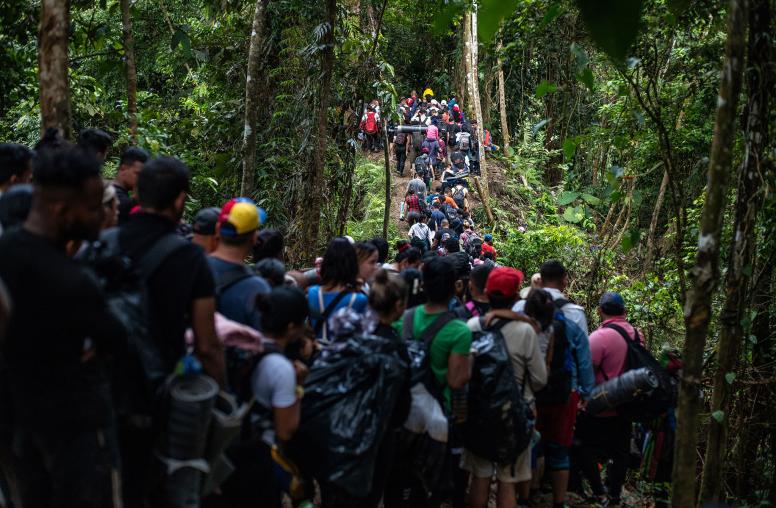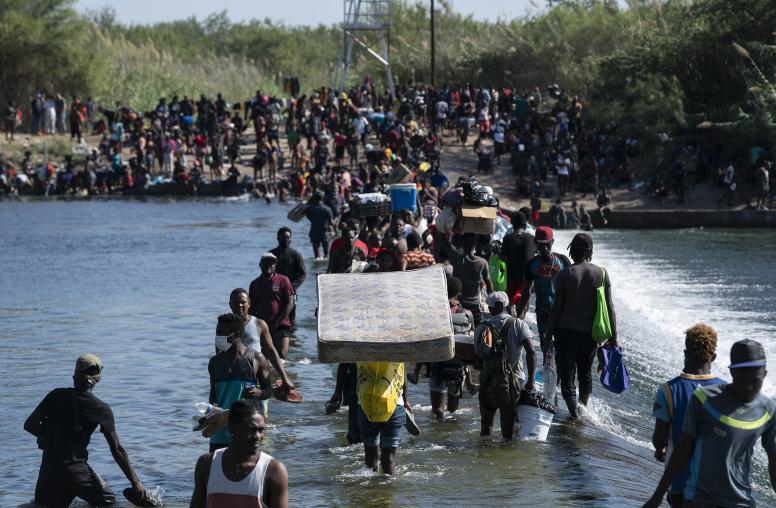Six Months in, Where Does the U.S.’ Pacific Islands Strategy Stand?
The new strategy has generated high expectations in the Pacific Islands. Now comes the challenge of sustaining U.S. engagement.
In September 2022, the United States announced the Pacific Partnership Strategy, its first-ever roadmap for the region, amid increasing geopolitical competition between China and the United States and its partners. However, the strategy only makes one reference to Beijing — most of the text details how Washington will tackle the challenges that have been identified as priorities by the Pacific Island countries themselves, especially the climate crisis. This reflects the U.S. government’s understanding that, while some regional leaders have expressed their own concerns about China, Pacific Island countries want Washington to engage with them for their own sake, not just to counter Beijing.

The announcement of the strategy and the first-ever U.S.-Pacific Islands Summit at the White House raised regional expectations, and the test of success will be in the follow-through. The strategy lists four main objectives: “A strong U.S.-Pacific Islands partnership; a united Pacific Islands region connected with the world; a resilient Pacific Islands region prepared for the climate crisis and other 21st-century challenges; [and] empowered and prosperous Pacific Islanders.” More than six months have passed since the summit, and now is a good moment to reflect on what the United States has done to achieve these objectives so far.
Objectives One and Two: Strengthening U.S. Partnerships and Pacific Regionalism
The United States has already made steady progress on enhancing its relationships with the Pacific Islands, a key objective listed early in the strategy. This has been especially true for the Republic of Palau, the Republic of the Marshall Islands and the Federated States of Micronesia — countries that have Compacts of Free Association with the United States. In January and February 2023, the United States signed memorandums of understanding with the three countries that reflect a shared understanding of the levels and types of future U.S. assistance they will receive under the economic provisions of the compacts. The Biden administration’s proposed budget to renew funds for these agreements is $7.1 billion over 20 years — a significant increase from the current levels — and congressional approval is still required.
The Biden administration will also need Capitol Hill’s approval for another cash infusion in the Pacific Islands. In 2022, prior to the announcement of the Pacific Partnership Strategy, the White House announced its intention to request nearly triple the funds from Congress for the South Pacific Tuna Treaty, which the administration describes as a “cornerstone of political and economic cooperation between the United States and Pacific Islands.” The treaty allows the United States to fish in Pacific Island countries’ exclusive economic zones and includes a subsidiary agreement for economic aid to the region.
The United States has also made progress on its objective to increase the overall U.S. diplomatic presence and engagement in the region. In February, the United States reopened its embassy in Solomon Islands after 30 years, and is now also looking to establish embassies in Vanuatu, Tonga and Kiribati. The United States is also working toward a defense cooperation agreement (DCA) with Papua New Guinea, while the U.S. Coast Guard is expanding its operations and reach in the region.
Meanwhile, high-level visits have helped to underscore Washington’s commitment. In January, Admiral John C. Aquilino, commander of U.S. Indo-Pacific Command, visited Papua New Guinea. In March, a high-level U.S. delegation led by National Security Council Coordinator for the Indo-Pacific Kurt Campbell visited Papua New Guinea, Solomon Islands, Vanuatu and Fiji to meet with their prime ministers and top government officials. The meetings focused on climate, education, health care, economic development, maritime resources and support for the Pacific Islands Forum and its 2050 Strategy for the Blue Pacific Continent. Also in March, the assistant secretary of state for conflict and stabilization operations, Anne Witkowsky, visited Papua New Guinea to kick off implementation of the United States’ new 10-year plan to promote stability.
The second objective in the strategy, “a united Pacific Islands region connected with the world,” aims to bolster regional bodies — the most prominent of which is the Pacific Islands Forum (PIF). The United States has appointed Ambassador Frankie Reed as the U.S. special envoy to the PIF, and there has been speculation that President Biden may attend the next leaders’ meeting in the Cook Islands later this year. In some ways, practical progress is harder to measure on this objective because the activities that sit under it are less visible than embassy openings and high-level visits. Pacific regionalism has indeed been strengthened in the six months since the summit, but the role (if any) of the United States is difficult to discern.
Objectives Three and Four: Resilience and Prosperity
The final two parts of the strategy are expansive in scope. Objective three includes what will likely be the most scrutinized component of the strategy: what the United States is going to do to “combat the climate crisis and build climate resilience.” The Pacific Islands are responsible for a vanishingly small proportion of global CO2 emissions, yet they stand to face some of the most severe effects of climate change. In March, USAID announced $3.2 million in humanitarian assistance to support Vanuatu after two devastating cyclones, and also announced $5.5 million in nine new grants to bolster Pacific Island countries’ resilience to the effects of climate change. In March, the United States also announced $5.8 million for the Resilient Pacific Blue Economies Program.
But combating the climate crisis in the Pacific cannot be addressed by regional strategies alone. The Pacific Islands also look to the United States to reduce its own emissions and address the impacts of climate change globally. At the COP 27 conference in Egypt in November, the United States accepted the principle of a “loss and damage” fund for countries affected by climate change, and negotiations are underway to give the agreement practical form. But in March, the United States abstained from a U.N. resolution — championed by Vanuatu since last year — seeking an advisory opinion on climate change from the International Court of Justice. The Pacific Islands will closely watch how the United States approaches these types of efforts, and will judge U.S. policies accordingly.
The other areas of engagement included in objectives three and four — aimed at increasing regional prosperity — range from maritime security to economic development, health, education and the return of the Peace Corps. In October, the United States and the Federated States of Micronesia signed an expanded shiprider agreement, and over the last six months the U.S. Coast Guard has been working there and in other Pacific Island countries to combat illegal fishing and strengthen local capacity. In March, the United States committed to establishing a technical assistance workshop to explore educational initiatives in Solomon Islands, and allocated funds to build an intensive care unit at Vila Central Hospital in Vanuatu.
The United States also seeks to address an important war legacy issue. The Pacific Partnership Strategy makes a commitment to “enhancing efforts to build host nation capacity to identify and remove unexploded ordnance to protect the health and safety of people in the Pacific.” In pursuit of this, the United States announced in December a $1 million project in Solomon Islands to build local disposal capacity and to map the extent of the problem — the first time such mapping has been done in the Pacific.The project has immense potential to grow and expand, as there is always more that needs to be done, including in other affected countries.
What’s Not There and What Comes Next?
The Pacific Partnership Strategy is off to a good start, but the United States must ensure that it can sustain its engagement in the region over the coming years and decades. Many of the objectives of the strategy — such as bolstering economies, strengthening partnerships and supporting good governance — simply take time. The challenge going forward will be to make tangible progress on the agreements and commitments that have emerged from the last six months. Given the importance of relationships in the Pacific, having senior officials make the journey is crucial, but the relationships must also be sustained over time.
There is a risk of over-promising and under-delivering with the Pacific Partnership Strategy, especially with so much funding dependent upon congressional approval. It remains to be seen whether Congress will approve the Biden administration’s proposed budget for its global climate policies, as well as the funds requested for the South Pacific Tuna Treaty and the Compacts of Free Association. The compacts, especially, will be closely watched. Because of the United States’ close ties with the Freely Associated States, the level of U.S. funding for these agreements is widely seen by Pacific Island countries as an indicator of Washington’s commitment to the region more broadly.
There is also much anticipation in the Pacific Islands for the return of the Peace Corps to four Pacific Island countries, and the expansion of the program to others. But the lack of adequate health infrastructure in many Pacific Island countries, such as Kiribati, poses a challenge for Peace Corps volunteers. The United States must address this issue, as outlined in the strategy, for the sake of Pacific Island countries themselves — until then it remains a barrier to one of the most high-profile and beloved forms of U.S. soft power. Where the Peace Corps cannot go, the United States should consider expanding the reach of the U.S. Army’s civic action teams.
Finally, the United States should consider how its other regional policies will impact the Pacific Islands and their reception of the Pacific Partnership Strategy. There was some concern in the region that the announcement of Partners in the Blue Pacific in June 2022 was done without enough consultation. Reactions to the latest AUKUS announcement were mixed, with some regional leaders welcoming it and others sharing a variety of concerns — though the United States has since alleviated some of them. In the Pacific, approach matters, and holding sufficient consultations early on can go a long way toward assuaging these kinds of concerns — as well as demonstrating the desire for true partnership.

